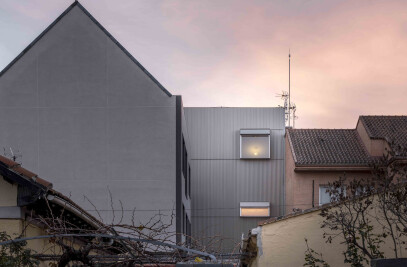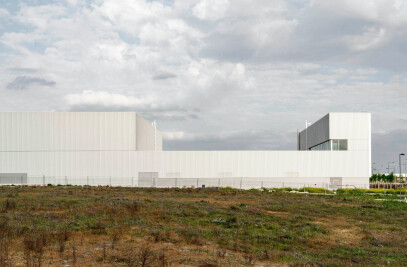An architecture project is presented under the following conditions. A couple bought one of the very few urban plots over the sea that is still unbuilt in the Cantabrico sea coast. After scouting every sea village from Plentzia to San Vicente de la Barquera for nearly a year, they found the place they where looking for in a residential estate from the 70’s near to Loredo, a suburban Santander vacation village. The plot is highly sloped over a 30 meters high cliff where waves brake. Northern sea wind is too brave and violent to let non protected trees grow. Whenever someone from the dry interior land arrives, wanders why houses face south and never to the sea. South orientation and sun are most appreciated by people from the highlands who come around to buy a holiday house, while the sea is just obvious. “We, on the contrary, come from far away looking for the sea, the wind, the waves, and therefore decided to get plot number 21, although going against the tide”.
Plot size 90 x 50, 4500 m2 and 8% building rate, that is, 360 square meters. Basement not included. Maximum height 3 meters eaves, 6 meters total. Distance to the lateral edges 10 meters, and 12 to the back street axis. 11 meters drop. 30 minutes walk to Langre Beach and 10 to the eastern end of Puntal Beach, whose opposite end closes Santander Bay. Cantábrico horizon from west, Cabo Mayor, to east, Cabo de Ajo.
A new topography is defined in order to protect a back south garden from the persistent sea wind. The building is enclosed in a 22x22 square metres based prism, whose height is three and a half meters. The most visible façade of the house is the green vegetal roof. The main program is developed in the first floor, over a ground floor that consists of garage, facilities, storage, porch and south garden. None of the pieces over the roof is higher than the horizon line seen from the street.
The will of disturbing as less as possible in the visual topography of the landscape led us to glue the house to the ground and find out façade and roof solutions that had a direct relationship with the surroundings. The idea of a “grabbed building” guides the decisions about volume, position, occupation, exterior outfit and façade claddings.
The property requires a holiday house program (although everybody knows it will become their permanent home), conditioned by its use intensity variation in terms of number of inhabitants, or season. This program complexity (couple, family, friends; summer, winter; weekend, long terms) is solved attending to values of low energy, spatial simplicity and use flexibility. The house’s program arranged in perpendicular stripes to the longitudinal plot axis is the following (in proximity to the sea): living/dining/library + office; Santander room + bathroom + toilet/storage + kitchen + double bathroom + multiview room; vertical patio + north hall + access patio; introvert room + indiscreet bathroom + brief space + flexible space + open bathroom + tub room; void patio + south hall + fern patio; multiple room + bathroom + south raised living + bathroom + no vacancies room. OS HOUSE is ready.
The Experience of Simple Complexity OS House allowed us to put an architectural experiment into practice. The owners challenged us with a programme of unusual complexity for this typology that reflected very differing needs. Firstly, a possible variation in the number of users of the house, from two to 30 or more, and all the possibilities between. Secondly, the usual seasonal variations in the house of a second home were exacerbated by the number of users. A final factor that was introduced into this array of possibilities was the uncertain future of this programme. The owners’ age, the future growth of their children’s families and a possible change from second to first home were the final factors in a situation to which we had to respond with clockwork precision and, at the same time, with sufficient slack to accommodate changes in the programme that cannot be identified in advance.
We quickly realised that the experiment should centre on the search for a model of floor plan that would absorb the contemporary time flows expressed in the demands of the programme and we were able to recite our working hypothesis: to explore the possibility of organising a complex domestic space by means of the simple addition of basic spaces.
We defined the limits of a work plan, addressing decisions of scale and relation with the setting, and the stipulations of planning regulations. We came up with several models, adjusting surface areas, wall thicknesses, systems of spatial relation and conditions of use, till the process gelled at a point from which we extracted the definitive solution.
Let’s take a recount: the floor plan of the dwelling is made up of 30 basic spaces associated in 48 simple pairs and 132 complex relations. The basic spaces represent a fragment of the programme and a degree of uncertainty. For example, we have the ‘kitchen’ space that will probably continue to be the ‘kitchen’ space for a long time. The uncertainty in this case is nil. But then we have spaces such as the ‘large south living room’, which has a high level of uncertainty because it could be a dormitory, a children’s playroom or a winter living room. The most extreme case of uncertainty centres in the north and south hallways, because as yet no one knows what they will be used for, through various proposals have been made. The simple pairs comprise two basic spaces joined by an empty floor-to-ceiling space. The complex relations are those that include an itinerary between two basic spaces via a third. The system of addition has had some comforting effects on the spatial complexity of the dwelling. The floor plan of OS House is defined as a field of multiple possibilities.

































